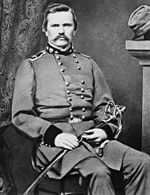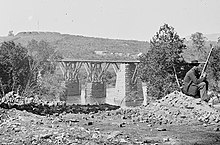Sanders' Knoxville Raid
Blocked from seizing Knoxville by its 1,000 Confederate defenders, Sanders' horsemen destroyed a major bridge across the Holston River at Strawberry Plains on the East Tennessee and Virginia Railroad.
After wrecking a smaller bridge at Mossy Creek, the raiders turned northwest, evading pursuers by slipping through an obscure gap in the Cumberland Plateau.
Since the start of the Civil War, President Abraham Lincoln and other government authorities urged Union generals to invade East Tennessee.
There were no railroads linking the region with Union-occupied areas of Kentucky, and the wagon roads across the Cumberland Plateau became very difficult to use in bad weather.
[1] On April 27, 1863, the Union XXIII Corps was formed from the regiments stationed in Kentucky and put under the command of Major General George Lucas Hartsuff.
[4] While waiting for the return of IX Corps, Burnside ordered a cavalry raid to destroy important railroad bridges east and west of Knoxville.
Despite his Southern upbringing, Sanders remained loyal to the Union, fighting at the battles of Williamsburg and Antietam[5] before being appointed colonel of the 5th Kentucky Cavalry Regiment on March 4, 1863.
This feint worked so well that the Confederate department commander Brigadier General Simon Bolivar Buckner massed the bulk of his troops at Clinton, 15 mi (24 km) northwest of Knoxville.
As they approached Kingston, the Union horsemen discovered that Colonel John S. Scott's Confederate cavalry brigade was in the town, so Sanders crossed the Clinch River 8 mi (13 km) to the northeast to avoid it.
Sanders' raiders cut the telegraph line, burned the depot, seized 75 horses and mules, and destroyed 2,500 weapons, 5 pieces of artillery, ammunition, and military equipment.
[10] That evening, when 8 mi (13 km) west of Knoxville, Union skirmishers encountered some Confederate pickets and Dr. James Harvey Baker, who was armed with a rifle and pistol and intending to join in the defense of the city.
[12] At 7 pm on June 19, Sanders left the 1st Kentucky to watch the west side of Knoxville while he circled around the city with the rest of his raiders to approach it from the north.
The Union column continued moving east along the railroad, destroying a bridge at Flat Creek about 4 mi (6.4 km) southwest of Strawberry Plains.
Sanders sent Moore and the 44th Ohio to make a dismounted attack, while other troops under Byrd and Dow attempted to cut off the bridge guard's retreat.
Aware that his column was the target of Confederate forces, Sanders left the railroad and made a dash for Rogers' Gap in Cumberland Mountain.
[14] Sanders' column forded the Holston River at Hayworth's Bend and headed for Powder Springs Gap in Clinch Mountain.
When approaching Rogers' Gap (near Speedwell), the Union column discovered the road obstructed with felled trees and defended by infantry and artillery.



